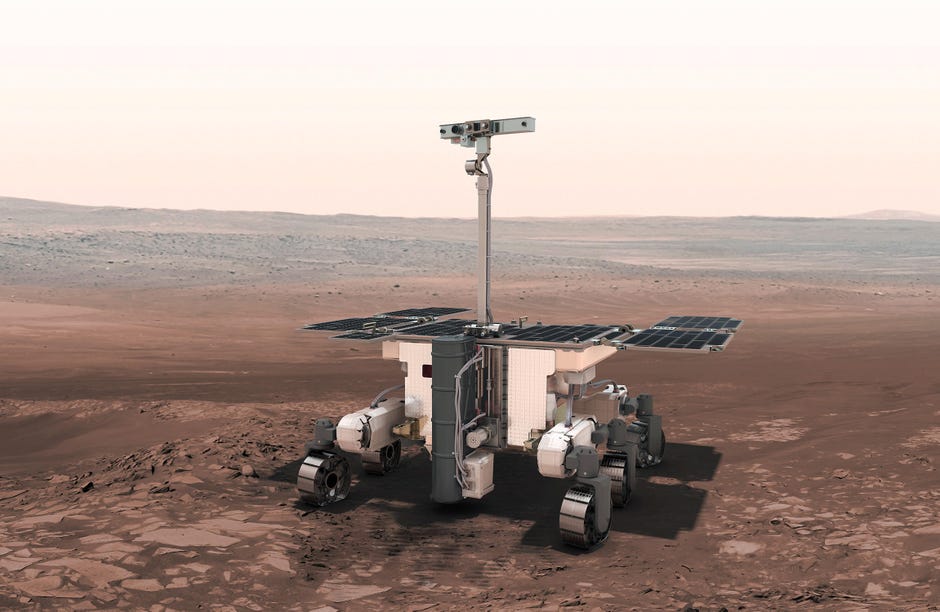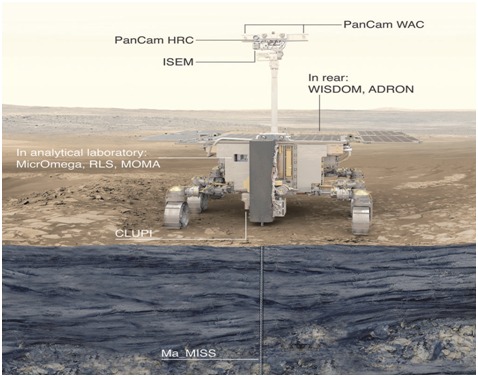“Science, for me, gives a partial explanation for life. In so far as it goes, it is based on fact, experience and experiment.” –Rosalind Franklin

Rosalind Franklin ExoMars Rover (Image Source: European Space Agency (ESA))
The Discovery of the structure of DNA is the most phenomenal breakthrough in the history of mankind. “The dark lady of DNA” refers to Rosalind Franklin, an unsung hero who had not been acknowledged for her contributions to the discovery of the DNA structure will finally get the respect she deserved on Mars.
To honour her work, the European Space Agency (ESA) is planning to send the Rosalind Franklin ExoMars Rover next year to find telltale biosignatures (signatures and evidence of ancient life) on Mars, but this time, from deep inside the martian subsurface using a unique set of instruments that have not been utilised for this purpose by any other Mars rover previously.
Why Martian Subsurface?
Data obtained from multiple rovers and orbiters have shown how the present-day Martian surface is exposed to extreme cosmic and UV radiation and the presence of salts like perchlorates makes it inhospitable for any form of life as we know it, to thrive.
They might also destroy and oxidize organics which might provide a possible hint of life. In comparison, a subsurface environment at a certain depth might be much more promising for martian life to exist, not hindered by those harsh conditions on the surface.
The presence of subsurface liquid water accompanied by the right amount of energy and a delicate balance of redox reactions might be conducive for martian life. Biosignatures, if present in the subsurface will be better preserved as compared to those present on the surface.
Geology meets biology:
Life alters its own environment in different ways. There are mainly two broad categories of biosignatures–morphological and chemical, which are supported by geological evidence and context. Many geological pieces of evidence obtained from minerals, rocks, etc., on Earth, provide us with ample evidence of ancient life, even if any clue of life (ex-fossils) might not be found.
These specific geological and geochemical changes can not be likely caused by any non-biological phenomena. Finding such geological clues hint towards a possible ancient life in the environment. This is precisely why Curiosity and Perseverance rovers are so fascinated with rocks on the surface.
Although a ground-penetrating radar on Perseverance, called RIMFAX (Radar Imager for Mars’ Subsurface exploration) aims to analyse the geological features of the subsurface, researchers on Earth want to penetrate deep inside the surface and get a good look at the subsurface geochemical status of Mars.
Methane is closely associated with life on Earth. Seasonal fluctuations of methane on Mars have been reported by the Curiosity rover. A possible way to explain these weird phenomena is the presence of methanogens— organisms that produce methane from carbon dioxide.
However, a biosignature observed in a potentially habitable system can be concluded to be a phenomenon caused by life only when all other possible explanations fail. The methane mystery might in reality be caused by non-biological (abiotic) processes we are not yet aware of.
Indeed, some abiotic geological processes produce methane. Therefore, Carl Sagan said,” Extraordinary claims require extraordinary evidence”.
Hydrothermal vents are the weirdest and the most fascinating oceanic deep habitats on Earth. At high temperatures, water reacts with olivine rocks to yield hydrogen, a process called serpentinization. Carbon dioxide present in the water reacts with the hydrogen emitted to yield methane, a process that can be achieved by both abiotic and biotic processes.
These processes are also called water-rock interactions. The presence of water and the possibility of similar serpentinization-like geochemistry if appropriate conditions exist in the subsurface might be a false positive of life. Conversely, it also might indicate that subsurface conditions are indeed conducive for martian life to originate, as life on Earth is thought to have originated from hydrothermal vents.

A hydrothermal vent system on Earth. (Image Source: Ocean Exploration Trust)
Rosalind Franklin rover aims to do what no rover has ever done before: to look at potential biosignatures 2m below the surface, using a specialized drill.
Well, preserved material of the subsurface will be analyzed for biosignatures by next-gen analytical instruments on the rover. Geochemical changes with the concerning depth can help researchers determine the approximate depth at which the subsurface might be habitable. Who knows, we might even find a clue to solve the enigmatic methane mystery on Mars?
Subsurface investigation relevant instruments on ExoMars:
A subsurface drill can collect samples up to a depth of 2m, a depth at which the concentration of oxidants and level of radiation is estimated to be appreciably low. At this level, some geologic evidence of water might also be found.
Therefore, this is the appreciable depth to find life. The samples collected will be distributed to the analytical laboratory(AL) which consists of a suite of instruments to analyse the sample for the presence of possible organics. The instruments will be explained in detail.
We need to consider the possibility of the sample(which might contain organics) getting altered as soon as they are removed from their native subsurface state to the harsh Martian environment while distributing them to the AL, rendering the sample analysis useless.
For this purpose, the drill is equipped with a miniaturized infrared spectrometer, the Ma_MISS(Mars multispectral imager for subsurface studies), which will analyse the geological status of the subsurface walls as it drills and thus provide real-time data to support the analysis made by other instruments on the surface.
A close-up imager (CLUPI) will also image the subsurface textures in detail to search for morphological biosignatures that might be formed only by martian biotic processes.
Analytical Laboratory (AL) instruments:
After the sample is collected, it will be distributed and passed through several instruments for specifically analysing extremely interesting life-relevant organics and minerals.
Grains of the sample will be analysed by MicroOmega, a Visible and IR range spectrometer to examine the mineralogy(texture, size, composition), etc., and correlate the results to determine the sample’s geological origin and other associated features.
After this initial screening, they will be prepared for further analysis by two advanced spectroscopy techniques, RLS (Raman Laser Spectrometer) and MOMA (Mars Organic Molecular Analyzer).
This will be the second mission after Perseverance to send a Raman spectrometer for Mars exploration. They are fast, sensitive instruments that require no sample preparation before the sample can be analysed. Sample preparation involves exposing the sample to heat and harmful chemicals which might destroy the original state of the sample.
This is an advantage over other types of spectroscopic techniques like the one used by Curiosity, where the samples collected had to be prepared before analysis and then passed through the Sample Analysis at Mars (SAM) instrument.
The RLS instrument will analyse the geological processes of the rock concerning the water-mineral and water-rock interactions taking place at the subsurface. It will also have the capability to differentiate between carbon produced inorganically or organically.
Hence, these interactions indicate the possibility of a habitable subsurface, as mentioned earlier.
After RLS analysis, the sample will be passed to the largest instrument on the rover, MOMA. This instrument will specifically search for chemical biosignatures and organics in the sample, even if the concentration is extremely low.
MOMA is not a single instrument, it is a combination of multiple instruments which have their methods to analyse the samples for different properties of organic molecules (ex-amino acids) to assess its source-biotic or abiotic.
Other instruments on the rover:
Finally, a set of instruments to assess the geological features of the region from which a particular sample is collected will be analysed using multiple panoramic and IR spectrometric imagers to better correlate the findings obtained from the Analytic laboratory instruments and the area from which the sample has been obtained from and to establish its geological context.
Looking at the rocks at the surface to study mineralogy, identifying water-associated minerals, and establishing a geological context of the surface is also an integral part of the mission.
To support the analysis of the instruments mentioned above, the rover carries an instrument to estimate the level of subsurface water and the presence of subsurface ice called ADRON (active detector for gamma rays and neutrons).
A similar kind of instrument called DAM(Dynamic Albedo of Neutrons) is also used by Curiosity to detect the presence of water under the surface. Both of them fire neutrons deep into the surface, and if water is present, hydrogen present in the water slows down these neutrons, and these slow neutrons are detected at the surface by these instruments.
Conclusion:
Rosalind Franklin ExoMars rover will be launched in 2022 and will reach Mars by 2023. The main aim of this mission is to detect potential biosignatures which indicate the presence of extinct, ancient life deep within the subsurface.
Although the rover consists of instruments with capabilities to detect extant(old but living) life too, researchers of this mission are skeptical about that possibility.
Finally, a much-needed geochemical characterization of the subsurface explored by the rover will be extremely fruitful to planetary geologists and astrobiologists in the future.
Author

